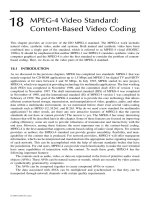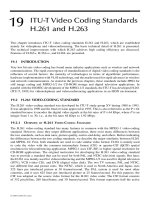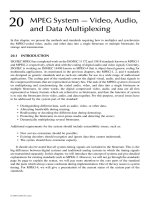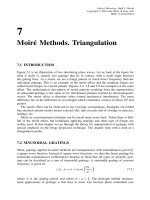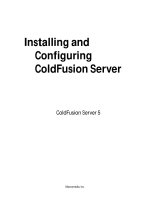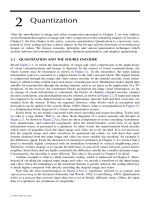Tài liệu Image and Videl Comoression P7 doc
Bạn đang xem bản rút gọn của tài liệu. Xem và tải ngay bản đầy đủ của tài liệu tại đây (431.29 KB, 12 trang )
Section II
Still Image Compression
© 2000 by CRC Press LLC
7
© 2000 by CRC Press LLC
Still Image Coding
Standard: JPEG
In this chapter, the JPEG standard is introduced. This standard allows for lossy and lossless encoding
of still images and four distinct modes of operation are supported: sequential DCT-based mode,
progressive DCT-based mode, lossless mode and hierarchical mode.
7.1 INTRODUCTION
Still image coding is an important application of data compression. When an analog image or
picture is digitized, each pixel is represented by a fixed number of bits, which correspond to a
certain number of gray levels. In this uncompressed format, the digitized image requires a large
number of bits to be stored or transmitted. As a result, compression become necessary due to the
limited communication bandwidth or storage size. Since the mid-1980s, the ITU and ISO have
been working together to develop a joint international standard for the compression of still images.
Officially, JPEG [jpeg] is the ISO/IEC international standard 10918-1; digital compression and
coding of continuous-tone still images, or the ITU-T Recommendation T.81. JPEG became an
international standard in 1992. The JPEG standard allows for both lossy and lossless encoding of
still images. The algorithm for lossy coding is a DCT-based coding scheme. This is the baseline
of JPEG and is sufficient for many applications. However, to meet the needs of applications that
cannot tolerate loss, e.g., compression of medical images, a lossless coding scheme is also provided
and is based on a predictive coding scheme. From the algorithmic point of view, JPEG includes
four distinct modes of operation, namely, sequential DCT-based mode, progressive DCT-based
mode, lossless mode, and hierarchical mode. In the following sections, an overview of these modes
is provided. Further technical details can be found in the books by Pennelbaker and Mitchell (1992)
and Symes (1998).
In the sequential DCT-based mode, an image is first partitioned into blocks of 8
¥
8 pixels.
The blocks are processed from left to right and top to bottom. The 8
¥
8 two-dimensional Forward
DCT is applied to each block and the 8
¥
8 DCT coefficients are quantized. Finally, the quantized
DCT coefficients are entropy encoded and output as part of the compressed image data.
In the progressive DCT-based mode, the process of block partitioning and Forward DCT
transform is the same as in the sequential DCT-based mode. However, in the progressive mode,
the quantized DCT coefficients are first stored in a buffer before the encoding is performed. The
DCT coefficients in the buffer are then encoded by a multiple scanning process. In each scan, the
quantized DCT coefficients are partially encoded by either spectral selection or successive approx-
imation. In the method of spectral selection, the quantized DCT coefficients are divided into multiple
spectral bands according to a zigzag order. In each scan, a specified band is encoded. In the method
of successive approximation, a specified number of most significant bits of the quantized coefficients
are first encoded and the least significant bits are then encoded in subsequent scans.
The difference between sequential coding and progressive coding is shown in Figure 7.1. In
the sequential coding an image is encoded part by part according to the scanning order, while in
the progressive coding the image is encoded by a multiscanning process and in each scan the full
image is encoded to a certain quality level.
As mentioned earlier, lossless coding is achieved by a predictive coding scheme. In this scheme,
three neighboring pixels are used to predict the current pixel to be coded. The prediction difference
© 2000 by CRC Press LLC
is entropy coded using either Huffman or arithmetic coding. Since the prediction is not quantized,
the coding is lossless.
Finally, in the hierarchical mode, an image is first spatially down-sampled to a multilayered
pyramid, resulting in a sequence of frames as shown in Figure 7.2. This sequence of frames is
encoded by a predictive coding scheme. Except for the first frame, the predictive coding process
is applied to the differential frames, i.e., the differences between the frame to be coded and the
predictive reference frame. It is important to note that the reference frame is equivalent to the
previous frame that would be reconstructed in the decoder. The coding method for the difference
frame may use the DCT-based coding method, the lossless coding method, or the DCT-based
processes with a final lossless process. Down-sampling and up-sampling filters are used in the
hierarchical mode. The hierarchical coding mode provides a progressive presentation similar to the
progressive DCT-based mode, but is also useful in the applications that have multiresolution
requirements. The hierarchical coding mode also provides the capability of progressive coding to
a final lossless stage.
FIGURE 7.1
(a) Sequential coding, (b) progressive coding.
FIGURE 7.2
Hierarchical multiresolution encoding.
© 2000 by CRC Press LLC
7.2 SEQUENTIAL DCT-BASED ENCODING ALGORITHM
The sequential DCT-based coding algorithm is the baseline algorithm of the JPEG coding standard.
A block diagram of the encoding process is shown in Figure 7.3. As shown in Figure 7.4, the
digitized image data are first partitioned into blocks of 8
¥
8 pixels. The two-dimensional forward
DCT is applied to each 8
¥
8 block. The two-dimensional forward and inverse DCT of 8
¥
8 block
are defined as follows:
(7.1)
where
s
ij
is the value of the pixel at position (
i,j
) in the block, and
S
uv
is the transformed (
u,v
) DCT
coefficient.
FIGURE 7.3
Block diagram of a sequential DCT-based encoding process.
FIGURE 7.4
Partitioning to 8
¥
8 blocks.
FDCT:
IDCT:
SCC s
iu
jv
sCCS
iu
jv
CC
for u v
otherwise
uv u v ij
ji
ij u v uv
vu
uv
=
+
()
p
+
()
p
=
+
()
p
+
()
p
=
=
Ï
Ì
Ô
Ó
Ô
==
==
ÂÂ
ÂÂ
1
4
21
16
21
16
1
4
21
16
21
16
1
2
0
1
0
7
0
7
0
7
0
7
cos cos
cos cos
,
© 2000 by CRC Press LLC
After the forward DCT, quantization of the transformed DCT coefficients is performed. Each
of the 64 DCT coefficients is quantized by a uniform quantizer:
(7.2)
where the
S
quv
is the quantized value of the DCT coefficient,
S
uv
, and
Q
uv
is the quantization step
obtained from the quantization table. There are four quantization tables that may be used by the
encoder, but there is no default quantization table specified by the standard. Two particular quan-
tization tables are shown in Table 7.1.
At the decoder, the dequantization is performed as follows:
(7.3)
where
R
quv
is the value of the dequantized DCT coefficient. After quantization, the DC coefficient,
S
q
00
, is treated separately from the other 63 AC coefficients. The DC coefficients are encoded by
a predictive coding scheme. The encoded value is the difference (
DIFF
) between the quantized DC
coefficient of the current block (
S
q
00
) and that of the previous block of the same component (
PRED
):
DIFF
=
S
q
00
–
PRED
(7.4)
The value of
DIFF
is entropy coded with Huffman tables. More specifically, the two’s com-
plement of the possible
DIFF
magnitudes are grouped into 12 categories, “SSSS”. The Huffman
codes for these 12 difference categories and additional bits are shown in the Table 7.2.
For each nonzero category, additional bits are added to the codeword to uniquely identify which
difference within the category actually occurred. The number of additional bits is defined by “SSSS”
and the additional bits are appended to the least significant bit of the Huffman code (most significant
bit first) according to the following rule. If the difference value is positive, the “SSSS” low-order
bits of
DIFF
are appended; if the difference value is negative, then the “SSSS” low-order bits of
DIFF
-
1
are appended. As an example, the Huffman tables used for coding the luminance and
chrominance DC coefficients are shown in Tables 7.3 and 7.4, respectively. These two tables have
been developed from the average statistics of a large set of images with 8-bit precision.
TABLE 7.1
Two Examples of Quantization Tables Used by JPEG
S round
S
Q
quv
uv
uv
=
Ê
Ë
Á
ˆ
¯
˜
RS Q
quv quv uv
=¥
© 2000 by CRC Press LLC
In contrast to the coding of DC coefficients, the quantized AC coefficients are arranged to a
zigzag order before being entropy coded. This scan order is shown in Figure 7.5.
According to the zigzag scanning order, the quantized coefficients can be represented as:
ZZ(0) = S
q00
, ZZ(1) = S
q01
, ZZ(2) = S
q10
, …., ZZ(63) = S
q77
. (7.5)
Since many of the quantized AC coefficients become zero, they can be very efficiently encoded
by exploiting the run of zeros. The run-length of zeros are identified by the nonzero coefficients.
An 8-bit code ‘RRRRSSSS’ is used to represent the nonzero coefficient. The four least significant
bits, ‘SSSS’, define a category for the value of the next nonzero coefficient in the zigzag sequence,
which ends the zero run. The four most significant bits, ‘RRRR’, define the run-length of zeros in
the zigzag sequence or the position of the nonzero coefficient in the zigzag sequence. The composite
value, RRRRSSSS, is shown in Figure 7.6. The value ‘RRRRSSSS’ = ‘11110000’ is defined as
ZRL, “RRRR” = “1111” represents a run-length of 16 zeros and “SSSS” = “0000” represents a
zero amplitude. Therefore, ZRL is used to represent a run-length of 16 zero coefficients followed
TABLE 7.2
Huffman Coding of DC Coefficients
SSS
S DIFF Values Additional Bits
00 –
1 –1,1 0,1
2 –3,–2,2,3 00,01,10,11
3 –7,…,–4,4,…,7 000,…,011,100,.,111
4 –15,…,–8,8,…,15 0000,.,0111,1000,…,1111
5 –31,…,–16,16,…,31 00000,…,01111,10000,…,11111
6 –63,…–32,32,…63 ….,…
7 –127,…,–64,64,…,127 ….,…
8 –255,…,–128,128,…,255 ….,…
9 –511,…,–256,256,…,511 ….,…
10 –1023,…,–512,512,…,1023 ….,…
11 –2047,…,–1024,1024,…,2047 ….,…
TABLE 7.3
Huffman Table for Luminance
DC Coefficient Differences
Category Code Length Codeword
0
1
2
3
4
5
6
7
8
9
10
11
2
3
3
3
3
3
4
5
6
7
8
9
00
010
011
100
101
110
1110
11110
111110
1111110
11111110
111111110
© 2000 by CRC Press LLC
by a zero-amplitude coefficient, it is not an
abbreviation
. In the case of a run-length of zero
coefficients that exceeds 15, multiple symbols will be used. A special value ‘RRRRSSSS’ =
‘00000000’ is used to code the end-of-block (EOB). An EOB occurs when the remaining coefficients
in the block are zeros. The entries marked “N/A” are undefined.
TABLE 7.4
Huffman table for chrominance
DC coefficient differences
Category Code Length Codeword
0
1
2
3
4
5
6
7
8
9
10
11
2
2
2
3
4
5
6
7
8
9
10
11
00
01
10
110
1110
11110
111110
1111110
11111110
111111110
1111111110
11111111110
FIGURE 7.5
Zigzag scanning order of DCT coefficients.
FIGURE 7.6
Two-dimensional value array for Huffman coding.
© 2000 by CRC Press LLC
The composite value, RRRRSSSS, is then Huffman coded. SSSS is actually the number to
indicate “category” in the Huffman code table. The coefficient values for each category are shown
in Table 7.5.
Each Huffman code is followed by additional bits that specify the sign and exact amplitude of
the coefficients. As with the DC code tables, the AC code tables have also been developed from
the average statistics of a large set of images with 8-bit precision. Each composite value is
represented by a Huffman code in the AC code table. The format for the additional bits is the same
as in the coding of DC coefficients. The value of SSSS gives the number of additional bits required
to specify the sign and precise amplitude of the coefficient. The additional bits are either the low-
order SSSS bits of ZZ(k) when ZZ(k) is positive, or the low-order SSSS bits of ZZ(k)-1 when
ZZ(k) is negative. Here, ZZ(k) is the
kth
coefficient in the zigzag scanning order of coefficients
being coded. The Huffman tables for AC coefficients can be found in Annex K of the JPEG standard
(jpeg) and are not listed here due to space limitations.
As described above, Huffman coding is used as the means of entropy coding. However, an
adaptive arithmetic coding procedure can also be used. As with the Huffman coding technique, the
binary arithmetic coding technique is also lossless. It is possible to transcode between two systems
without either of the FDCT or IDCT processes. Since this transcoding is a lossless process, it does
not affect the picture quality of the reconstructed image. The arithmetic encoder encodes a series
of binary symbols, zeros or ones, where each symbol represents the possible result of a binary
decision. The binary decisions include the choice between positive and negative signs, a magnitude
being zero or nonzero, or a particular bit in a sequence of binary digits being zero or one. There
are four steps in the arithmetic coding: initializing the statistical area, initializing the encoder,
terminating the code string, and adding restart markers.
7.3 PROGRESSIVE DCT-BASED ENCODING ALGORITHM
In progressive DCT-based coding, the input image is first partitioned to blocks of 8
¥
8 pixels. The
two-dimensional 8
¥
8 DCT is then applied to each block. The transformed DCT-coefficient data
are then encoded with multiple scans. At each scan, a portion of the transformed DCT coefficient
data is encoded. This partially encoded data can be reconstructed to obtain a full image size with
lower picture quality. The coded data of each additional scan will enhance the reconstructed image
quality until the full quality has been achieved at the completion of all scans. Two methods have
been used in the JPEG standard to perform the DCT-based progressive coding. These include
spectral selection and successive approximation.
TABLE 7.5
Huffman Coding for AC Coefficients
Category (SSSS) AC Coefficient Range
1 –1,1
2 –3,–2,2,3
3 –7,…,–4,4,…,7
4 –15,…,–8,8,…,15
5 –31,…,–16,16,…,31
6 –63,…,–32,32,…,63
7 –127,…,–64,.64,…,127
8 –255,…,–128,128,…,255
9 –511,…,–256,256,…,511
10 –1023,.,–512,512,…,1023
11 –2047,…,–1024,1024,…,2047
© 2000 by CRC Press LLC
In the method of spectral selection, the transformed DCT coefficients are first reordered as a
zigzag sequence and then divided into several bands. A frequency band is defined in the scan header
by specifying the starting and ending indexes in the zigzag sequence. The band containing the DC
coefficient is encoded at the first scan. In the following scan, it is not necessary for the coding
procedure to follow the zigzag ordering.
In the method of the successive approximation, the DCT coefficients are first reduced in
precision by the point transform. The point transform of the DCT coefficients is an arithmetic shift
right by a specified number of bits, or division by a power of 2 (near zero, there is slight difference
in truncation of precision between an arithmetic shift and division by 2, see annex K10 of [jpeg]).
This specified number is the successive approximation of bit position. To encode using successive
approximations, the significant bits of the DCT coefficient are encoded in the first scan, and each
successive scan that follows progressively improves the precision of the coefficient by one bit. This
continues until full precision is reached.
The principles of spectral selection and successive approximation are shown in Figure 7.7. For
both methods, the quantized coefficients are coded with either Huffman or arithmetic codes at each
scan. In spectral selection and the first scan of successive approximation for an image, the AC
coefficient coding model is similar to that used in the sequential DCT-based coding mode. However,
the Huffman code tables are extended to include coding of runs of end-of-bands (EOBs). For
distinguishing the end-of-band and end-of-block, a number, n, which is used to indicate the range
of run length, is added to the end-of-band (EOBn). The EOBn code sequence is defined as follows.
Each EOBn is followed by an extension field, which has the minimum number of bits required to
specify the run length. The end-of-band run structure allows efficient coding of blocks which have
only zero coefficients. For example, an EOB run of length 5 means that the current block and the
next 4 blocks have an end-of-band with no intervening nonzero coefficients. The Huffman coding
structure of the subsequent scans of successive approximation for a given image is similar to the
coding structure of the first scan of that image. Each nonzero quantized coefficient is described by
a composite 8-bit run length-magnitude value of the form: RRRRSSSS. The four most significant
bits, RRRR, indicate the number of zero coefficients between the current coefficient and the
previously coded coefficient. The four least significant bits, SSSS, give the magnitude category of
the nonzero coefficient. The run length-magnitude composite value is Huffman coded. Each Huff-
man code is followed by additional bits: one bit is used to code the sign of the nonzero coefficient
and another bit is used to code the correction, where “0” means no correction and “1” means add
one to the decoded magnitude of the coefficient. Although the above technique has been described
using Huffman coding, it should be noted that arithmetic encoding can also be used in its place.
7.4 LOSSLESS CODING MODE
In the lossless coding mode, the coding method is spatially based coding instead of DCT-based
coding. However, the coding method is extended from the method for coding the DC coefficients
in the sequential DCT-based coding mode. Each pixel is coded with a predictive coding method,
where the predicted value is obtained from one of three one-dimensional or one of four two-
dimensional predictors, which are shown in Figure 7.8.
In Figure 7.8, the pixel to be coded is denoted by x, and the three causal neighbors are denoted
by a, b, and c. The predictive value of x, Px, is obtained from three neighbors, a, b, and c in the
one of seven ways as listed in Table 7.6.
In Table 7.6, the selection value 0 is only used for differential coding in the hierarchical coding
mode. Selections 1, 2, and 3 are one-dimensional predictions and 4, 5, 6, and 7 are two-dimensional
predictions. Each prediction is performed with full integer precision, and without clamping of either
the underflow or overflow beyond the input bounds. In order to achieve lossless coding, the
prediction differences are coded with either Huffman coding or arithmetic coding. The prediction
© 2000 by CRC Press LLC
difference values can be from 0 to 2
16
for 8-bit pixels. The Huffman tables developed for coding
DC coefficients in the sequential DCT-based coding mode are used with one additional entry to
code the prediction differences. For arithmetic coding, the statistical model defined for the DC
coefficients in the sequential DCT-based coding mode is generalized to a two-dimensional form in
which differences are conditioned on the pixel to the left and the line above.
FIGURE 7.7
Progressive coding with spectral selection and successive approximation.
© 2000 by CRC Press LLC
7.5 HIERARCHICAL CODING MODE
The hierarchical coding mode provides a progressive coding similar to the progressive DCT-based
coding mode, but it offers more functionality. This functionality addresses applications with multi-
resolution requirements. In the hierarchical coding mode, an input image frame is first decomposed
to a sequence of frames, such as the pyramid shown in Figure 7.2. Each frame is obtained through
a down-sampling process, i.e., low-pass filtering followed by subsampling. The first frame (the
lowest resolution) is encoded as a nondifferential frame. The following frames are encoded as
differential frames, where the differential is with respect to the previously coded frame. Note that
an up-sampled version that would be reconstructed in the decoder is used. The first frame can be
encoded by the methods of sequential DCT-based coding, spectral selection, method of progressive
coding, or lossless coding with either Huffman code or arithmetic code. However, within an image,
the differential frames are either coded by the DCT-based coding method, the lossless coding
method, or the DCT-based process with a final lossless coding. All frames within the image must
use the same entropy coding, either Huffman or arithmetic, with the exception that nondifferential
frames coded with the baseline coding may occur in the same image with frames coded with
arithmetic coding methods. The differential frames are coded with the same method used for the
nondifferential frames except the final frame. The final differential frame for each image may use
a differential lossless coding method.
In the hierarchical coding mode, resolution changes in frames may occur. These resolution
changes occur if down-sampling filters are used to reduce the spatial resolution of some or all
frames of an image. When the resolution of a reference frame does not match the resolution of the
frame to be coded, a up-sampling filter is used to increase the resolution of the reference frame.
The block diagram of coding of a differential frame is shown in Figure 7.9.
FIGURE 7.8
Spatial relationship between the pixel to be coded and three decoded neighbors.
TABLE 7.6
Predictors for Lossless Coding
Selection-Value Prediction
0
1
2
3
4
5
6
7
No prediction (hierarchical mode)
Px = a
Px = b
Px = c
Px = a+b-c
Px = a + ((b-c)/2)
a
Px = b + ((a-c)/2)
a
Px = (a+b)/2
a
Shift right arithmetic operation.
© 2000 by CRC Press LLC
The up-sampling filter increases the spatial resolution by a factor of two in both horizontal and
vertical directions by using bilinear interpolation of two neighboring pixels. The up-sampling with
bilinear interpolation is consistent with the down-sampling filter that is used for the generation of
down-sampled frames. It should be noted that the hierarchical coding mode allows one to improve
the quality of the reconstructed frames at a given spatial resolution.
7.6 SUMMARY
In this chapter, the still image coding standard, JPEG, has been introduced. The JPEG coding
standard includes four coding modes: sequential DCT-based coding mode, progressive DCT-based
coding mode, lossless coding mode, and hierarchical coding mode. The DCT-based coding method
is probably the one that most of us are familiar with; however, the lossless coding modes in JPEG
which use a spatial domain predictive coding process have many interesting applications as well.
For each coding mode, entropy coding can be implemented with either Huffman coding or arithmetic
coding. JPEG has been widely adopted for many applications.
7.7 EXERCISES
7-1.
What is the difference between sequential coding and progressive coding in JPEG?
Conduct a project to encode an image with sequence coding and progressive coding,
respectively.
7-2.
Use the JPEG lossless mode to code several images and explain why different bit rates
are obtained.
7-3.
Generate a Huffman code table using a set of images with 8-bit precision (aproximately
2~3) using the method presented in Annex C of the JPEG specification. This set of
images is called the training set. Use this table to code an image within the training set
and an image which is not in the training set, and explain the results.
7-4.
Design a three-layer progressive JPEG coder using (a) spectral selection, and (b) pro-
gressive approximation (0.3 bits per pixel at the first layer, 0.2 bits per pixel at the second
layer, and 0.1 bits per pixel at the third layer).
REFERENCES
Digital compression and coding of continuous-tone still images. Requirements and Guidelines, ISO-/IEC
International Standard 10918-1, CCITT T.81, September, 1992.
Pennelbaker, W. B. and J. L. Mitchell,
JPEG: Still Image Data Compression Standard
, Van Nostrand Reinhold,
New York, 1992.
Symes, P.
Compression: Fundamental Compression Techniques and an Overview of the JPEG and MPEG
Compression Systems
, McGraw-Hill, New York, 1998.
FIGURE 7.9
Hierarchical coding of a differential frame.

